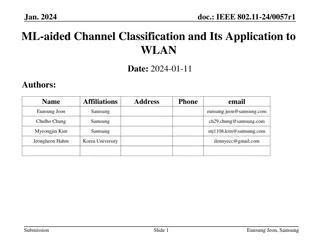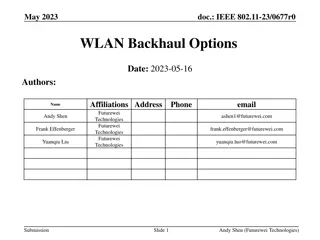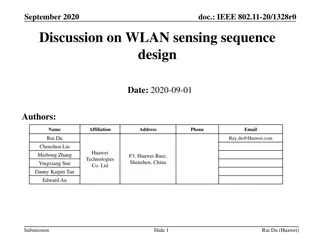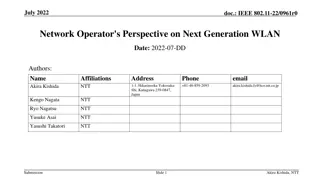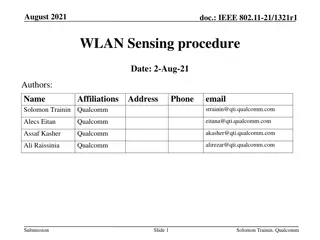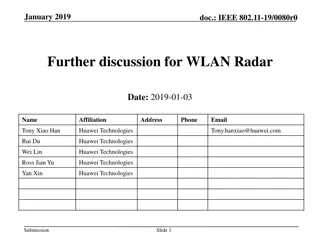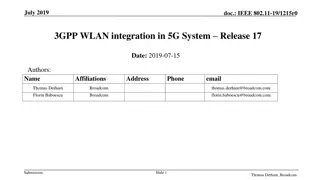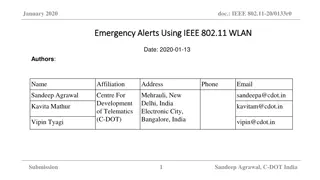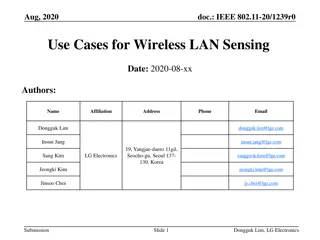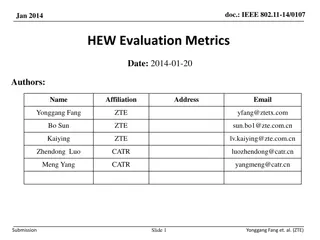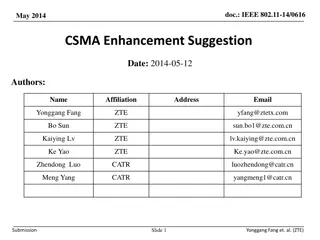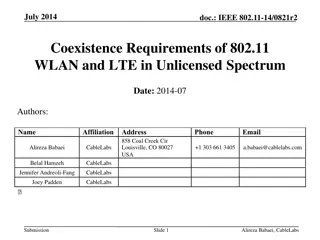
Wireless Local Area Networks and IEEE Standards
Explore the features of IEEE 802.11 WLANs, types of client hardware, and functions of infrastructure devices. Learn about de facto and de jure standards, IEEE working groups, and the evolution of IEEE 802.11 standards. Delve into the physical layer specifications and transmission methods of wireless networks.
Download Presentation

Please find below an Image/Link to download the presentation.
The content on the website is provided AS IS for your information and personal use only. It may not be sold, licensed, or shared on other websites without obtaining consent from the author. If you encounter any issues during the download, it is possible that the publisher has removed the file from their server.
You are allowed to download the files provided on this website for personal or commercial use, subject to the condition that they are used lawfully. All files are the property of their respective owners.
The content on the website is provided AS IS for your information and personal use only. It may not be sold, licensed, or shared on other websites without obtaining consent from the author.
E N D
Presentation Transcript
Chapter 3: Wireless Local Area Networks 1
Objectives Describe the features of the IEEE 802.11a/b/g/n/ac/ax WLANs List the different types of client hardware Describe the different functions of infrastructure devices 2
Sources of Standards De facto standards: Common practicesthat the industry follows for various reasons Ranging from ease of use to tradition to what majority of users do Usually established by success in marketplace QWER keyboard is an example De jure standards: Official standards Controlled by organization or body that has been entrusted with that task TCP/IP mode Endorsed by the Internet Engineering Task Force (IETF) 3
IEEE working groups are as follows: IEEE 802.11 Wireless local area networking IEEE 802.15 Wireless personal area networking IEEE 802.16 Broadband wireless metropolitan area networks IEEE 802.20 Mobile broadband wireless access IEEE 802.22 Wireless regional area networks 4
IEEE 802.11-2020 To reduce confusion, in 2020 IEEE combined the standards and amendments into a single standard The new, single standard specifies technical corrections and clarifications to the original The IEEE specifically defines 802.11 technologies at the Physical layer and the MAC sublayer of the Data-Link layer. IEEE 802.11-2020 Officially these retires all previous standards 5
802.11 Physical layer specifications Infrared : uses a light-based medium. Although an infrared medium was indeed defined in the original 802.11 standard, it has since been deprecated and removed from the standard. Frequency-hopping spread-spectrum (FHSS) Direct-sequence spread-spectrum (DSSS) 6
IEEE 802.11 Specified that wireless transmission could take place via infrared (IR) or radio signals Infrared Transmissions: Can send data by the intensity of the infrared light wave Light spectrum Light spectrum: All types of light Infrared light: Can be used for wireless transmissions Invisible Emitter Emitter: Device that transmits a signal Detector Detector: Device that receives a signal 7
IEEE 802.11 Infrared transmissions (continued): Transmissions can be either directed or diffused Directed transmission Directed transmission: requires that the emitter and detector be directly aimed at one another in a line of sight (LoS) path Diffused transmission Diffused transmission: relies on reflected light Emitters have a wide-focused beam instead of narrow and are pointed at a ceiling (reflection point) Disadvantages include lack of mobility, limited range, confined to indoor use, slow transmission speed 8
IEEE 802.11 Radio Wave Transmissions: Radio waves can penetrate through objects Provides mobility Radio waves travel longer distances Can be used indoors and outdoors Radio waves can travel at much higher speeds than infrared transmissions IEEE 802.11 standard outlining radio wave transmissions has become preferred method for wireless LANs 12
Types of Wireless LANs Since late 1990s, IEEE has approved seven standards for wireless LANs: IEEE 802.11 IEEE 802.11b IEEE 802.11a IEEE 802.11g IEEE 802.11n (WIFI 4) IEEE 802.11ac (WIFI 5) IEEE 802.11ax (WIFI 6) 13
IEEE 802.11a -1999 802.11a and 802.11b published at same time 802.11a came to market later due to technical issues and high production cost Uses 5GHz frequency Specifies maximum rated speed of 54 Mbps using 64 Quadrature Modulation (QAM) modulation it uses orthogonal frequency-division multiplexing (OFDM) , and Directs Sequence Spread Spectrum (DSSS) Spectrum Range of 802.11a around 30 m 14
IEEE 802.11b 1999 Uses 2.4 GHz frequency Specifies maximum rated speed of 11 Mbps using Complementary code keying (CCK-8bit) High rate-direct sequence spread spectrum (HR/DSSS) Supports wireless devices up to 107 meters Radio waves decrease in power over distance 802.11b standard specifies that, when devices move out of range to transmit at 11 Mbps, devices drop transmission speed to 5.5 Mbps 15
IEEE 802.11g 2003 Effort to combine best features of 802.11a and 802.11b Data transfer rates to 54 Mbps using 64 Quadrature Modulation (QAM) modulation Support devices up to 115 meters Uses 2.4 GHz frequency Extended rate physical-orthogonal frequency division multiplexing (ERP-OFDM) 16
IEEE 802.11n-2009 Uses two bands, 2.4 GHz and 5 GHz High-throughput orthogonal frequency division multiplexing (HT-OFDM) Physical layer (PHY) layer enhancements and Data Link layer (MAC) layer enhancements Data rates up to 600 Mbps 64 Quadrature Modulation (QAM) modulation Introduce Multiple-input multiple-output technology (MIMO) 18
MIMO IEEE 802.11a/b/g devices used a single radio to transmit and receive radio signals. This is known as single-input single- output (SISO) technology. MIMO uses multiple radios to transmit and receive radio signals. SISO systems are subject to multipath, in which several wavefronts of a signal would be received out of phase because of reflections. This is a problem for IEEE 802.11a/b/g systems, whereas MIMO actually uses the reflections from either a transmitter or a receiver to help enhance the performance and throughput using several radio chains in 802.11n. 19
IEEE 802.11ac-2013 Defines very high throughput (VHT) enhancements below 6 GHz Uses 5 GHz bands Data rates up to 6.9 Gbps using use 256-QAM modulation Introduces the use of multi-user MIMO (MU-MIMO) technology 20
IEEE 802.11ax-2019 Introduce high efficiency (HE) WLAN Operates in the 2.4 GHz, 5 GHz and 6 GHz frequency bands A key component of 802.11ax is orthogonal frequency-division multiple access (OFDMA) technology Data rates up to 9.6 Gbps using 1024-QAM modulation 21
WLAN Client Hardware Wireless hardware and software can be divided into: Wireless client network interface cards 22
Wireless Client Network Interface Card Network interface card (NIC): Network interface card (NIC): Connects computer to network so that it can send and receive data Today s computers typically have NIC components built directly into the motherboard NICs for wired networks have an RJ-45 connection used to connect the device to the network via a cable Wireless NICs perform same function, but without wires Categorized into wireless NIC devices for desktop computer and for portable devices 23
Cards for Desktops Internal wireless NICs have largely been replaced by external wireless NICs that plug into the Universal Serial Bus (USB) port Desktop computers are now shipping with wireless NICs as standard equipment (along with a wired NIC) 25
WLAN Infrastructure Wireless network infrastructure: Access points WLAN bridges WLAN repeaters Gateways Mesh Network Power over Ethernet devices 27
Access Points (APs) The wireless access point is an integral component of a WLAN infrastructure. Wireless access points allow a variety of wireless client devices access to any network resources that the device or user may have permissions for. An AP can operate as a stand-alone or It can also operate as part of a larger wireless, by sharing some of the same parameters, such as the service set identifier (SSID) which it is the logical name of the WLAN. 28
Access point 29
Access Points (APs) Three major parts: Antenna and radio transmitter/receiver To send and receive signals Special bridging software To interface wireless devices to other devices RJ-45 wired network interface Allows it to connect to a wired network Two basic function: Base station for wireless network Bridge between wireless and wired networks 30
Types of Access Point (APs) Autonomous Access Points also called Fat access point Lightweight Access Points Lightweight Access Points: also called thin access points or Controller managed cloud-managed (or controller-less ). 32
Access Point (APs) Autonomous Access Points: standard APs Considered independent because they are separate from other network devices Have intelligence to manage authentication, encryption, and other functions for wireless clients It is best suited for small networks with only a few access points or wireless hotspots, because they must be managed independently Types of Autonomous AP Consumer-grade; small office, home office-grade (SOHO-grade) enterprise-grade. 33
Autonomous Access Points Autonomous Access Points usually include : Network Address Translation (NAT) Dynamic Host Configuration Protocol (DHCP) Internet Protocol (IP) routing Built-in firewall SOHO Grade and enterprise Include Advanced security options Wireless bridge functionality and Wireless repeater functionality, and usually has much processing power 34
Lightweight Lightweight Access Point (APs) Lightweight Access Points Lightweight Access Points: also called thin access points Does not contain management and configuration functions, so they are not stand-alone devices Those features are contained in a central device called wireless LAN controller (WLC) or wireless switch WLC: distributes configuration information automatically to all lightweight access points 35
Lightweight access point with enterprise WLAN controller 36
Cloud-Managed Access Point (APs) Provides another solution for deploying WLAN infrastructures. The access points are managed through a cloud software configuration tool, eliminating the need for a hardware controller. Cloud-managed access points provide many of the same benefits and features of a WLAN controller solution without the need and extra expense of a hardware controller. 37
WLAN Bridges Bridge: Connects two network segments together Even if they use different types of physical media Wireless workgroup bridge: used to connect a wired network segment to a wireless network segment Remote wireless bridge: Connects two or more wired or wireless networks together that are separated by a longer distance using higher power and special antenna. 38
WLAN Repeaters Repeaters Extend distance between WLAN Repeaters function at Layer 1, so it cannot determine data traffic types and simply passes all data traffic across the device. A wireless repeater provides the capability for computers and other devices to connect to a WLAN even when outside the normal hearing range of the access point connected to the network. 42
Wireless Mesh Networks Wireless Mesh Network (WMN): when multiple mesh access points communicate between themselves Mesh access point does not have to be individually connected by a cable to an existing wired network Only one of the mesh access point in a WMN must be physically connected to the wired network 44
Power over Ethernet (PoE) Devices Devices that obtain power through the unused wires in a standard UTP Ethernet cable Eliminates the need to install electrical wiring where devices might need to be located PoE-enabled Ethernet switch: power sourcing equipment (PSE) that provides both electrical power and data PoE injectors: can inject power into an Ethernet cable A standard Ethernet switch can supply data while the PoE injector provides the power 46



